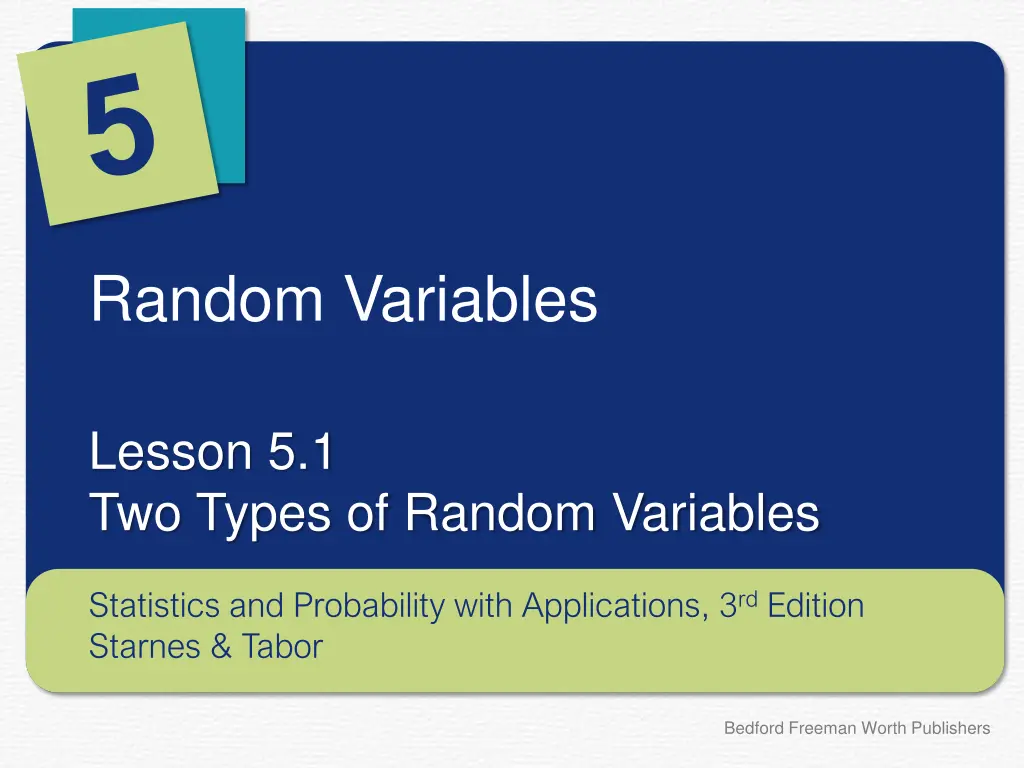
Understanding Discrete Random Variables and Probability Distributions
Learn about two types of random variables - discrete and continuous, and understand how to calculate probabilities with a focus on discrete random variables. Explore the concept of probability distributions and their applications in statistics and probability to analyze outcomes of chance processes.
Download Presentation

Please find below an Image/Link to download the presentation.
The content on the website is provided AS IS for your information and personal use only. It may not be sold, licensed, or shared on other websites without obtaining consent from the author. If you encounter any issues during the download, it is possible that the publisher has removed the file from their server.
You are allowed to download the files provided on this website for personal or commercial use, subject to the condition that they are used lawfully. All files are the property of their respective owners.
The content on the website is provided AS IS for your information and personal use only. It may not be sold, licensed, or shared on other websites without obtaining consent from the author.
E N D
Presentation Transcript
Random Variables Lesson 5.1 Two Types of Random Variables Statistics and Probability with Applications, 3rdEdition Starnes & Tabor Bedford Freeman Worth Publishers
Two Types of Random Variables Learning Targets After this lesson, you should be able to: Verify that the probability distribution of a discrete random variable is valid. Calculate probabilities involving a discrete random variable. Classify a random variable as discrete or continuous. Statistics and Probability with Applications, 3rdEdition 2 2
Two Types of Random Variables Suppose you toss a fair coin 3 times. The sample space for this chance process is HHH HHT HTH THH HTT THT TTH TTT Because there are 8 equally likely outcomes, the probability is 1/8 for each possible outcome. Define the random variable X = the number of heads obtained in 3 tosses. The value of X will vary from one set of tosses to another, but it will always be one of the numbers 0, 1, 2, or 3. How likely is X to take each of those values? X=0: TTT X=1: HTT THT TTH X=2: HHT HTH THH X=3: HHH We can summarize the probability distribution of X in a table: Statistics and Probability with Applications, 3rdEdition 3 3
Two Types of Random Variables Random Variable, Probability Distribution A random variable takes numerical values that describe the outcomes of a chance process. The probability distribution of a random variable gives its possible values and their probabilities. There are two main types of probability distributions, corresponding to two types of random variables: discrete and continuous. Statistics and Probability with Applications, 3rd Edition 4 4
Two Types of Random Variables Discrete Random Variable A discrete random variable X takes a fixed set of possible values with gaps between. The probability distribution of a discrete random variable X lists the values xi and their probabilities pi: In a valid probability distribution, the probabilities pi must satisfy two requirements: 1. Every probability pi is a number between 0 and 1, inclusive. 2. The sum of the probabilities is 1: p1 + p2+ + ... = 1. Statistics and Probability with Applications, 3rd Edition 5 5
Two Types of Random Variables We can use the probability distribution of a discrete random variable X to find the probability of an event. The probability distribution for X = the number of heads obtained when tossing a fair coin 3 times is: What s the probability that we get at least one head in 3 tosses of the coin? P(X 1) = P(X=1 or X=2 or X=3) Because the events X = 1, X = 2, and X = 3 are mutually exclusive, we can add their probabilities to get the answer: P(X 1) = P(X=1) + P(X=2) + P(X=3) = 1/8 + 3/8 + 3/8 = 7/8 Or we could use the complement rule from Lesson 4.2: P(X 1) =1 P(X < 1) = 1 P(X=0) = 1 1/8 = 7/8 Statistics and Probability with Applications, 3rd Edition 6 6
Two Types of Random Variables Suppose we want to randomly select a number between 0 and 1, allowing any number between 0 and 1 as the outcome (like 0.84522 or 0.1111119). The sample space of this chance process is the entire interval of values between 0 and 1 on a number line. If we define Y = the outcome of the random number generator, then Y is a continuous random variable. Continuous Random Variable A continuous random variable X can take any value in an interval on the number line. Most discrete random variables result from counting something. Continuous random variables typically result from measuring something. Statistics and Probability with Applications, 3rd Edition 7 7
LESSON APP 5.1 Making the grade? Indiana University Bloomington posts the grade distributions for its courses online. In a recent semester of a Business Statistics course, 45.7% of students received A s, 36.2% B s, 13.8% C s, 3.2% D s, and 1.1% F s. Choose a Business Statistics student at random. The student s grade on a 4-point scale (with A = 4) is a random variable X with this probability distribution: 1. 2. 3. 4. Is X a discrete or a continuous random variable? Explain. Show that the probability distribution of X is valid. Explain in words what P(X 3) means. What is this probability? Write the event the student got a grade worse than C using probability notation. What is the probability of this event? Statistics and Probability with Applications, 3rd Edition 8 8
Two Types of Random Variables Learning Targets After this lesson, you should be able to: Verify that the probability distribution of a discrete random variable is valid. Calculate probabilities involving a discrete random variable. Classify a random variable as discrete or continuous. Statistics and Probability with Applications, 3rd Edition 9 9
